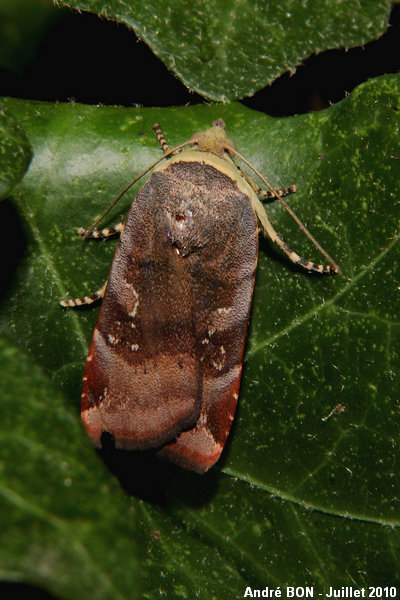
| Lesser Broad-bordered Yellow Underwing (Noctua janthe (Borkhausen, 1792)) |

|
|
Scientific name: Noctua janthe (Borkhausen, 1792) Common name: Lesser Broad-bordered Yellow Underwing French name: Collier soufré Order: Lepidoptera Suborder: Heterocera Family: Noctuidae Subfamily: Noctuinae Wingspan: 30-40 mm. Biotope: Open woodland areas, hedgerows, parks and gardens. Geographic area: Western Europe, north to southern Scandinavia and east to Poland, and North Africa. Flight time: July to September. Number of generations : 1 Caterpillar: Host plant: Many trees, shrubs and herbaceous plants, including the White Dead-nettle (Lamium album), the Broad-leaved Dock (Rumex obtusifolius) and the Scentless Mayweed (Matricaria perforata). |
The Lesser Broad-bordered Yellow Underwing has a yellowish creamy body and this colour is making some kind of a collar next to the base of the wings. The forewings are dark brown to greyish in the basal and costal areas. They are crossed by a dark subdiscal stripe. The submarginal area is more reddish with a darker reddish triangle-shape mark next to the outer edge. This mark shows three small white dots on the costal edge. The hind wings are bright yellow and marked with black near the base. They show a wide black marginal band. There is a possible confusion with Noctua janthina, though some experts consider that janthe and janthina are one unique species. The edge between the dark area and the pale marginal area, on the underside of the forewings, is linear on janthina while it appears wavy with an extension on each vein on janthe. The black marginal stripe, on the upper side of the hind wings is wider on janthina and extends near the costal edge to touch the black basal area. This black marginal stripe reaches the costal edge with an almost right angle on janthe. |
| [To know more about the Lesser Broad-bordered Yellow Underwing] [Top] |

|
It is impossible, on this picture, to see any of the keys which enable to differentiate Noctua janthe and Noctua janthina. So there is still a doubt … |